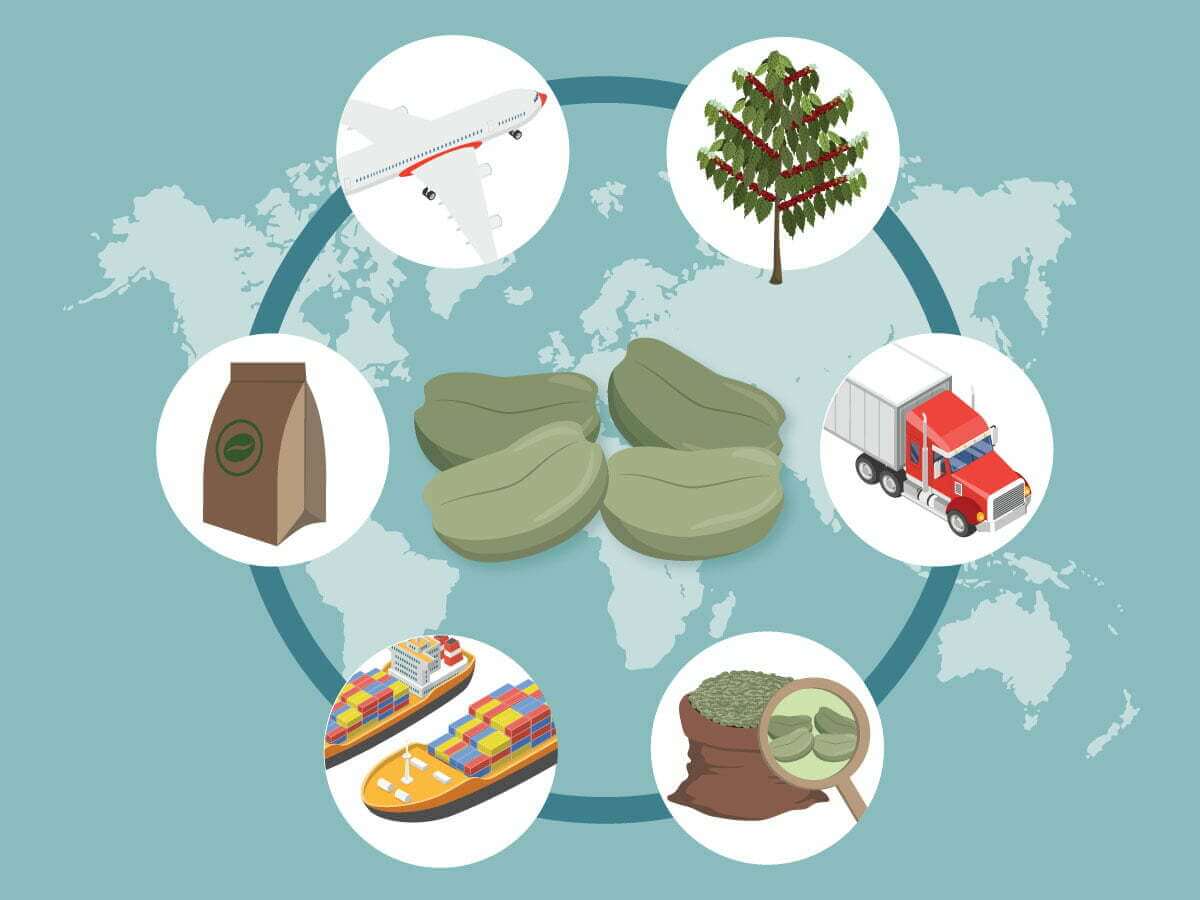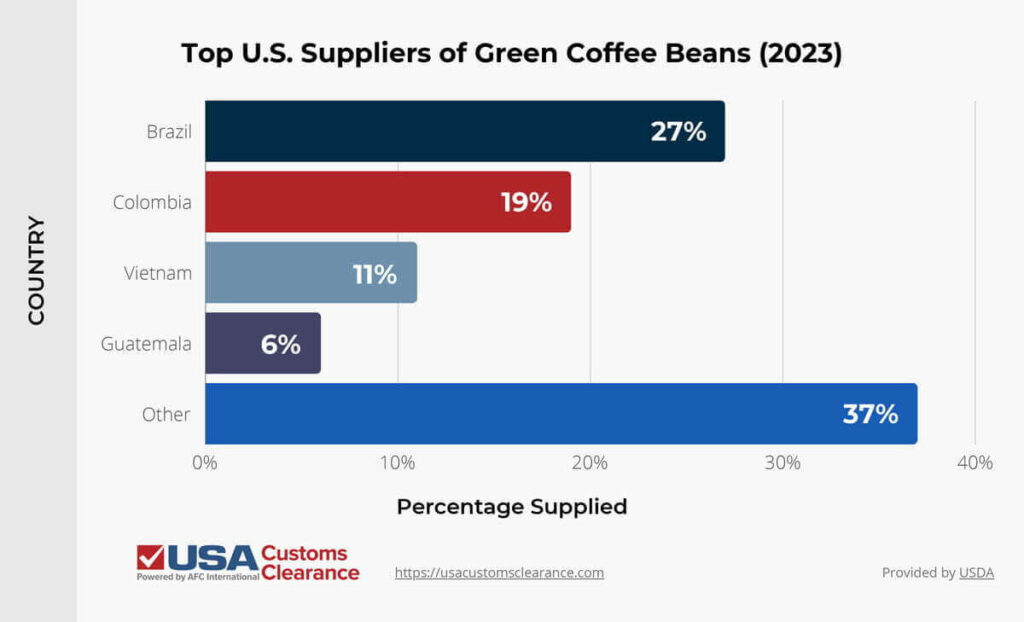
Green coffee beans are a very popular import, but to bring them stateside successfully, you’ll need to complete a few federal requirements.
Key takeaways:
In the guide below, I’ll take you through the specific requirements you’ll have to complete to safely import green coffee beans into the country.
If you intend to import green coffee beans into the U.S., you’ll need to follow all the FDA’s requirements. They’re quite explicit about what they need from importers. Failure to complete their requirements can lead to harsh consequences.
If you intend to import any kind of food intended for humans or animals into the U.S., you’ll need to file Prior Notice with the FDA. Performing this administrative task tells the FDA more about your intentions and the kind of business you run.
There are two ways that Prior Notice can be filed.
Ultimately, as the importer, the simplest way to handle this task is to work with a Licensed Customs Broker. These individuals handle all aspects of clearing shipments that are arriving in the U.S. including filing prior notice.
Our team of Licensed Customs Brokers at USA Customs Clearance have a deep understanding of the FDA Customs Clearance process. We’re fully aware of the requirements and make the process simple and easy.
In addition to the Prior Notice requirement, you’ll also need to fulfill FDA facility registration requirements. Essentially, any imported food arriving in the U.S. must come from facilities that are registered with the FDA. This safeguard is in place to ensure that imported food products meet quality and safety standards in place through the FDA.
At the time of import, FDA & CBP agents will review the shipment details to determine whether the imported coffee beans came from an FDA registered facility. If the products did not come from a registered facility, the shipment can be detained or returned to the shipper. Potential monetary penalties and bans on future shipments can also come into play.
The Foreign Supplier Verification Program (FVSP) is a mandatory regulation you’ll have to complete under the Food Safety Modernization Act (FSMA). The FDA will want you to complete the FVSP to prove your supplier of green coffee beans has adequate preventive controls that guarantee the safety of the product.
There are four specific FVSP requirements you need to fulfill:
Completing the FVSP isn’t always necessary. The FDA does provide guidance if you’re unsure if the program applies to you. Another option is to meet with one of our Licensed Customs Brokers by booking a consulting session.

We work with you every step of the way to ensure a smooth and stress-free customs experience.
The FDA also requires importers of pre-packaged consumer food products to follow specific guidelines related to nutrition and ingredient labeling. These labeling rules only come into play if the green coffee beans are packaged for consumers.
This likely won’t be the case for most green coffee bean imports. The majority of these products are shipped in bulk, non-consumer packaging. After clearing customs, most beans are then roasted before they’re packaged for consumers.
While not necessary, you can submit Affirmation of Compliance codes (A of C) for your import. The FDA will use these to verify if your products abide by their rules. By providing A of C codes, you might be able to speed up the screening process. This allows you to clear customs more quickly.
The United States Department of Agriculture (USDA) doesn’t require an import permit or other documentation for your green coffee beans to enter the country. However, these types of coffee beans cannot come into the U.S. through Hawaii or the territory of Puerto Rico.
This is due to various pest concerns that exist in the two countries. Your products will be inspected at the first port of entry. Goods that are found to have pests will either be destroyed or fumigated. It will be up to the Animal and Plant Health Inspection Service (APHIS) to decide.
USDA has two explicit requirements for importing organic coffee beans, one of which you’ll have to satisfy. The first is to certify your business as USDA organic, and the second is to import your goods from a country that has equivalent regulations.
You can certify your business by completing these five steps:
You can bypass these steps by importing your goods from a country that has organic requirements equivalent to the ones set by USDA. Sourcing from these nations will help you avoid the hassle of fess, inspections and unnecessary paperwork.
Countries that have USDA organic equivalence include:
To be fair, these countries aren’t exactly known for their production of green coffee beans. This means you’ll likely be importing from another country not on this list. In addition to these certification requirements, you’ll need to complete some other steps for your organic goods.
For one, you’ll have to make sure your goods are labeled correctly. This means placing a principal display panel (PDP) and an information panel (IP) on the packaging. There are four different organic labels that can apply to your green coffee beans.
The information on the PDP and IP will vary based on the label that applies to your shipment. You’ll need to make sure you use the correct one for your goods.
Related: Importing Organic Food Into the USA
Customs and Border Protection (CBP) doesn’t have specific regulations for the importation of green coffee beans. That said, they will want you to provide a variety of documents.
This includes:
If your shipment is arriving via the ocean, you’ll need to submit the Importer Security Filing (ISF). You’ll need to complete this at least 24 hours before your cargo is loaded onto a ship bound for the United States. The CBP strictly enforces this policy, as the minimum fine for failing to file the ISF is $5,000 for each violation.
Related: Documents Need To Import and Export
For the most part, the process of importing green coffee beans into the U.S. is the same as importing roasted coffee beans. However, green coffee beans are more likely to undergo additional inspection since they haven’t yet been roasted and are at a higher risk of foreign pest contamination.
If a foreign pest is found, your coffee beans will likely need to be fumigated before they move to the next step of their journey.
Providing the right Harmonized Tariff Schedule (HTS) code for your green coffee beans is extremely important. HTS codes are used to determine the duty rate for your goods. They also allow other government agencies to track and analyze data on products that enter the country.
Most HTS codes for coffee are duty free and can be found under the 0901 heading. If you don’t want to go through the trouble of finding the specific code for your shipment, then try using our HTS lookup tool.
Green coffee beans can be sourced from a variety of countries, especially ones located in Central and South America. To help narrow down your search, I’ve provided some data on the top countries that supplied the U.S. with these goods. Keep in mind, the data includes green coffee bean imports and other color variants.

Brazil is the world’s largest producer of coffee beans, which would explain why the U.S. uses the country as a source. Products from Brazil are known for well-rounded and high-quality flavor.
Colombia is the third-largest producer of coffee, with 11.5 million bags being made in 2023. All of their products are grown using Arabica plants. These are known for their sweet, smooth and chocolate-esque flavor.
Vietnam is another large producer of coffee beans. The products they make are renown for their bold flavors. Guatemala makes for a great place to source from as well. The high altitude and long history of growing these agricultural goods result in high-quality products.
If you need help importing green coffee beans, then look no further than USA Customs Clearance. We have a highly skilled and experienced team that knows the various federal regulations that must be completed. You can also obtain vital customs documents and other services to help you with your import.
Don’t put off your green coffee bean import any longer. Start using one of our services by clicking on the links. You can also reach our team for further assistance by contacting us through the site or by calling at (855) 912-0406.

 Copy URL to Clipboard
Copy URL to Clipboard
I'm looking to speak with a Customs Broker who is familiar with importing coffee from the Indian subcontinent via ship. I have looked at the CBP list of brokers on their website and it is just a large list of brokers, but as I mentioned I am trying to look for one who has worked or works with businesses/people from that area often.
I want to import green coffee beans from Ethiopia. Wants to get support for all the FDA, USDA, and CBP requirements. The final destination is Minnesota, and the port of entry is Chicago. I want to connect with a Licensed Customs Broker to simplify the import process for me, ensuring that green coffee beans move through customs quickly and without unnecessary delays. Can you provide the contact information of a Licensed Customs Broker who works in my area, please?
We would like to know what programs are available to import coffee beans roasted from Central America. We would need all details and pricing for the process.